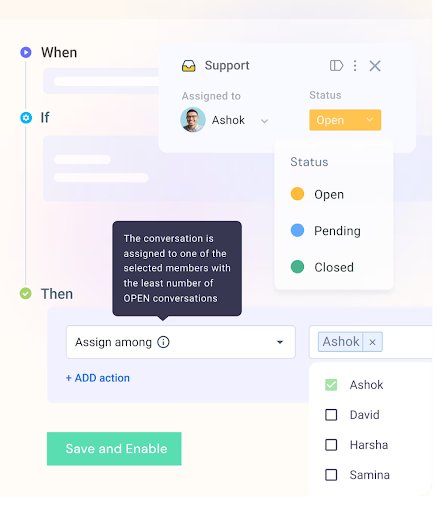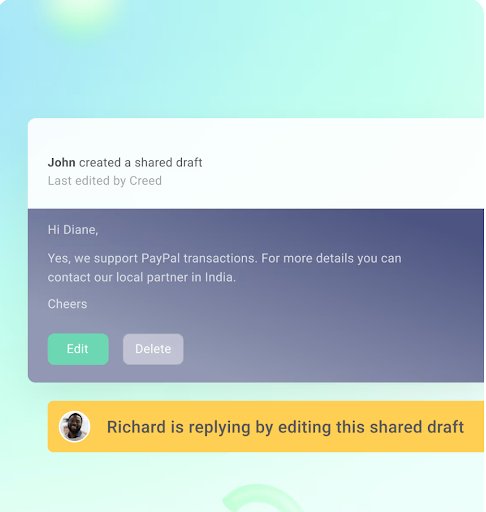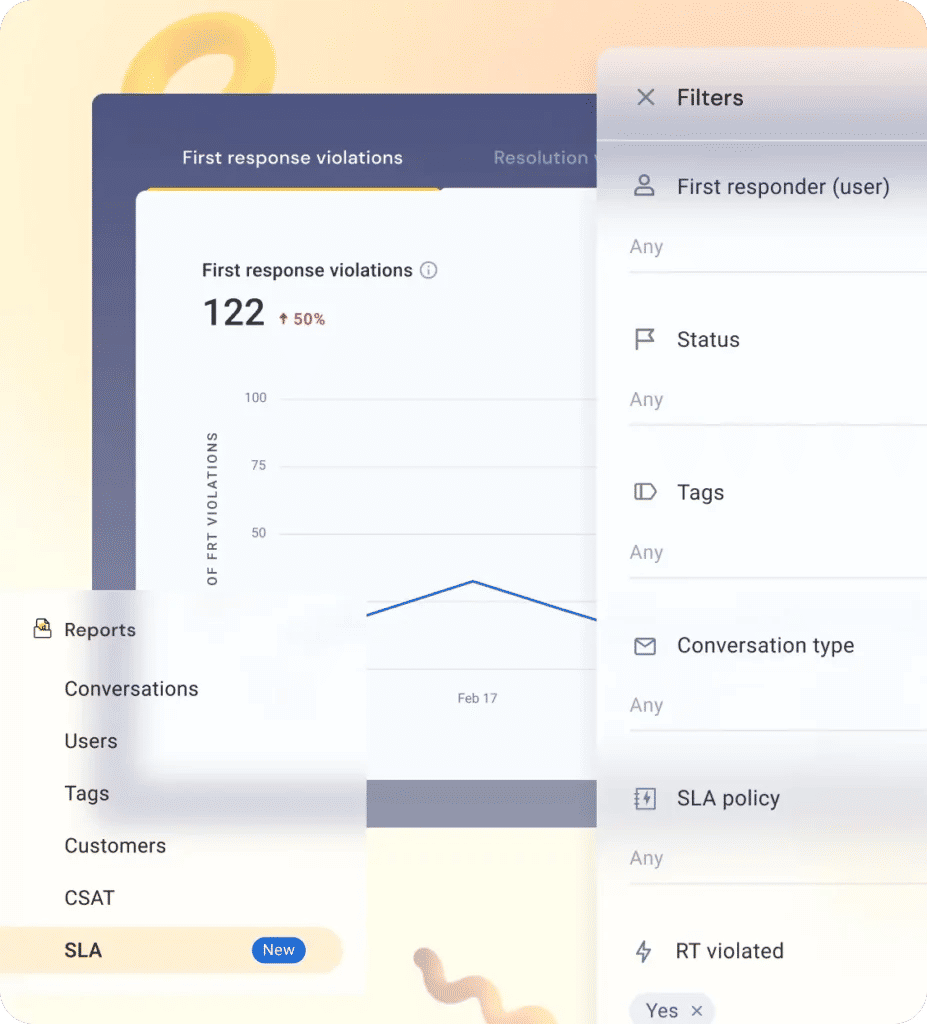35 hours
through Automations
32 hours
through Assignments
25 hours
through Email Notes
Established in 1867, Morgan State University (MSU) is Maryland’s largest Historically Black College and University (HBCU),with over 10,000 enrolled students. Recognized as a “National Treasure,” MSU offers more than 50 degree programs spanning undergraduate to doctoral levels.
Beyond traditional degree programs, MSU provides flexible courses and learning opportunities tailored to adult learners restarting their education or balancing studies with personal and professional commitments.
The Challenge: Managing Complexity and Volume
Supporting such a diverse student body alongside its broad academic offerings meant MSU’s operations team faced a constant influx of inquiries from students, parents, faculty, and external stakeholders.
This complexity made email management an ongoing challenge. The team grappled with missed communications and manual workflows, which delayed responses and disrupted their ability to meet deadlines.
To resolve these issues, Operations Manager Maia Maclin and Interim Manager of Student Success Emma Minnis sought a solution to streamline query handling and ensure no communications slipped through the cracks.
Maia and Emma explained their growing challenges in managing incoming queries across their inboxes. The high volume of inquiries forced them to juggle multiple shared inboxes, including
[email protected] and [email protected].
The team experimented with tools like Google Groups, Boomerang, and Gmelius to manage emails, but none delivered the efficiency they needed. Maia Maclin shared:
“We used Google Groups and manually tagged emails, but it didn’t help us stay on top of things… We even tried Boomerang and Gmelius, but they weren’t effective for our workflow.”
These limitations led to recurring issues:
- Missed Emails: The team relied on manual tracking, which often resulted in oversights. Maia admitted,
“We scrolled through inboxes weekly, hoping nothing had been missed.”
- Overloaded Team Members: Without an organized system, emails piled up and this was overwhelming the staff. Sorting through cluttered inboxes wasted time and delayed responses to stakeholders.
- Manual Email Assignments: Assigning emails manually consumed significant time and left critical queries unresolved. This also meant that nobody had a clear visibility of who is handling what, which led to confusion further delaying responses.
The Solution: Simplifying Email Management with Hiver
When Morgan State University began searching for an email management solution, they explored several options—including tools like Zoho, Front, and Zendesk. However, none fully addressed their needs.
Maia emphasized:
“I work in front of four screens! The number of tabs we have open is insane. Switching between tabs kills productivity—I needed something that worked directly within my Gmail inbox.”
After careful evaluation, the MSU team chose Hiver for its seamless integration with Gmail and robust features tailored to their specific needs
1. Auto-assignments to avoid delays
Before switching to Hiver, Maia and her team used Google’s collaborative inbox to receive all incoming emails. They manually sorted and assigned emails to team members—a process that
consumed significant time, created confusion, and caused delays. Tracking important messages became a struggle, leading to missed responses.
Hiver’s assignment feature resolved this issue. The team now uses automated rules to assign incoming queries to the right department or teammate as soon as they arrive. Additionally, round-robin distribution ensures balanced workloads.

With these changes, Maia’s team is able to address incoming queries immediately. No more hours wasted sorting and assigning emails to the right person.
Maia noted:
“We can’t afford to miss deadlines—and with Hiver’s automation, we don’t.”
2. Notes and shared drafts for internal collaboration
Before switching to Hiver, MSU’s operations team relied on forwarding emails or using their internal chat system and Google Chat to coordinate responses. This approach often caused confusion and slowed communication—particularly for cases requiring input from multiple departments.
Emma Minnis, Interim Manager of Student Success, recalled:
“We constantly messaged each other with updates like, ‘Hey, I’ve responded to this student,’ which was time-consuming and inefficient.”
Hiver’s Shared Drafts and Notes features solved this problem. By using shared drafts, multiple departments collaborate on crafting responses to email queries. This ensures cohesive replies without missing critical details. The best part? Drafts are created within Gmail’s familiar interface. Teams receive real-time notifications if someone is working on a draft, preventing conflicting responses.

Maia’s team also uses Hiver’s Notes and @mention feature to streamline collaboration. Whenever they need to highlight important details in a query, they add a note directly beside the email and @mention the relevant person for quick feedback. Notes also help track progress on complex cases. Maia added:
“We love our notes. If a student emails the president claiming no one responded, we can pull up our notes and show exactly what happened.”

3. Email templates for faster responses
MSU’s team receives numerous queries about SOPs, processes, applications, and related topics. These inquiries were highly repetitive. Before switching to Hiver, teams rewrote responses manually each time, consuming hours crafting replies to identical questions.
Emma described the challenge:
“We constantly rewrote emails for the same issues. Coordinating consistent responses across the team became especially difficult when new members joined.”
Hiver’s template feature transformed this process. Now, the team creates canned responses for FAQs, saving them in designated folders. When a recurring question arrives, they simply retrieve the template, personalize it if needed, and hit ‘send.’
These templates serve as response foundations while allowing customization. As Maia Maclin explained:
“We rely heavily on templates. They let us answer quickly while still adding a personal touch where needed.”

Emma highlighted an added benefit:
“Templates give everyone access to standardized answers. They’ve been invaluable for training new hires and maintaining consistency in our communication.”
In short, Hiver’s templates help MSU save time, reduce errors, and ensure uniform messaging across all responses.
4. Monitoring SLAs and customizing business hours for better support
Earlier, MSU’s operations team struggled to communicate their business hours effectively. They lacked a system to share their unique schedule—a problem compounded by the team occasionally working beyond standard hours. As Maia explained:
“As a state university, our hours differ from typical schedules. For example, we remain open on Veterans Day—a national holiday—but observe our own university breaks. Previously, we couldn’t communicate these exceptions to stakeholders.”
This misalignment confused both the team and students. Without the ability to configure customized business hours, meeting response expectations proved challenging.
Hiver resolved this issue with its SLA management feature. MSU now defines business hours that reflect their actual operating schedule, even during non-standard periods. This ensures seamless operations without compromising SLA adherence.

Business hours are set directly within Gmail. When stakeholders submit queries, they automatically receive notifications outlining response SLAs tailored to MSU’s availability.
Hiver also enables teams to set, track, and monitor SLAs. The operations team now uses these metrics to gain clear visibility into overdue emails, allowing Maia to proactively address bottlenecks.
Maia emphasized the impact:
“I use SLAs and analytics to coach the team and set expectations. Tracking overdue emails and response times ensures we stay on track and meet deadlines.”

Result: Streamlined Email Management and Improved Productivity
Hiver transformed Morgan State University’s email management efforts and helped the team overcome longstanding workflow challenges. With Hiver, the operations team has been able to streamline processes, consistently meet deadlines, and improve communication accuracy. Maia Maclin and Emma Minnis emphasize how Hiver empowers them to handle queries efficiently while delivering exceptional support to students.

The Hiver advantage
Favourite features
Beyond its features, Maia and Emma praised Hiver’s support team for their responsiveness and attentiveness.
Maia shared:
“I love how well-maintained everything is. I don’t need another fire to put out—Hiver ensures things run smoothly.”
Emma described Hiver’s support team as “very accommodating and great listeners,” highlighting the strong partnership they built. The 24/7 availability of Hiver’s support team added further value.
Here’s how Hiver drove measurable results:
- Boosted Productivity by 90%: The team eliminated time wasted manually searching through emails. Maia noted, “Productivity has increased by 90%… You’re not spending hours tracking responses anymore.”
- Reduced Missed Emails to Less Than 1%: Automation features nearly eradicated overlooked inquiries. Maia added, “Since adopting Hiver, we miss fewer than 1% of emails.”
- Enhanced Collaboration: Teams used shared drafts and notes to work seamlessly across departments. Leadership leveraged these tools to craft unified responses and monitor complex cases.
- Improved Student Experience: Faster, accurate responses built student trust. Emma explained that missing queries leaves a poor impression on students, and Hiver has helped make sure that doesn’t happen ever.



 Location
LocationBaltimore, Maryland
 Industry
IndustryHigher Education
 Goals
GoalsStreamline email assignments and improve response time



 Continue with Google
Continue with Google
 Continue with Microsoft
Continue with Microsoft



































